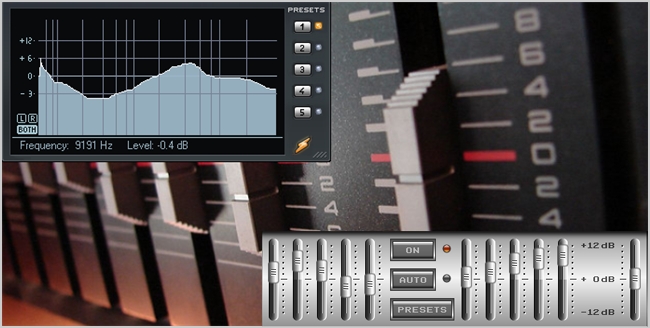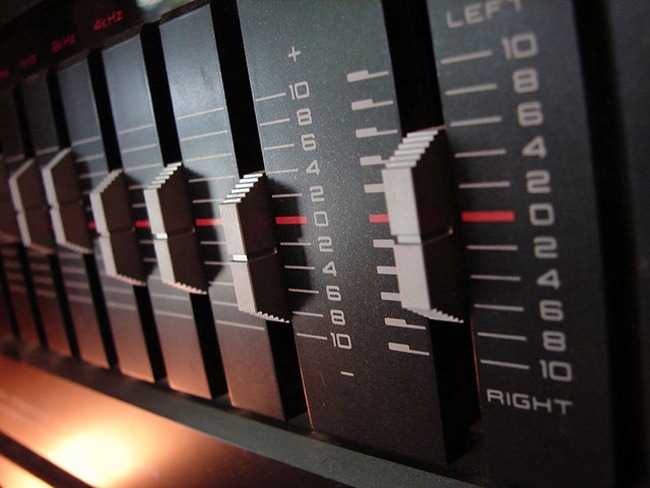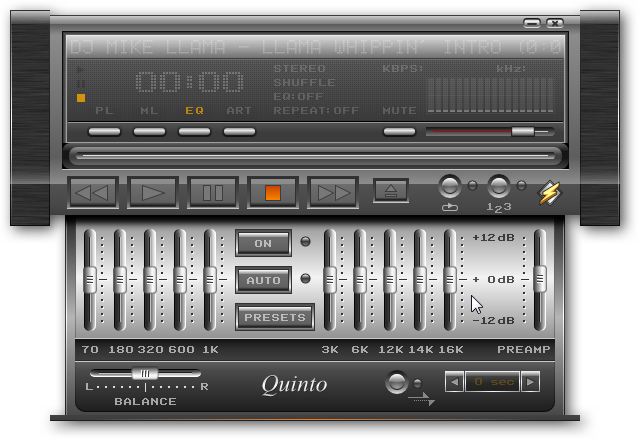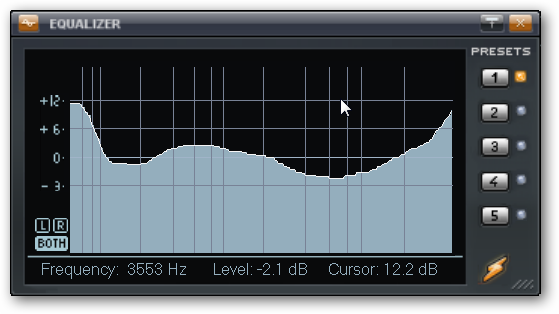
濾波器和均衡器有什么區別

It’s in your car, home theater system, phone, and audio player but it doesn’t have an instruction manual. It’s an equalizer, and with a little know-how you can tweak your audio and fall in love with it all over again.
它在您的汽車,家庭影院系統,電話和音頻播放器中,但沒有說明手冊。 這是一個均衡器,只需一點技巧,您就可以調整音頻并重新愛上它。
等于什么? (Equalizing What?)
Equalizers are software or hardware filters that adjust the loudness of specific frequencies. As with all sound engineering, the basis is on the human ear. Certain frequencies are louder than others to our ears, despite having the same or even more energy behind it. Our range is around 20-20,000 Hz, and the closer we approach or exceed these boundaries, the softer things sound. Compounded by the fact that our cars, rooms, and speakers are in various shapes, sizes, and configurations, the same note from the same instrument can sound completely different, let alone a whole song! That’s why ancient amphitheaters were designed with acoustic projections in mind, so voices could carry.
均衡器是調整特定頻率響度的軟件或硬件濾波器。 與所有聲音工程一樣,基礎在于人耳。 盡管某些頻率具有相同或什至更多的能量,但它們對我們的耳朵來說比其他的聲音響亮。 我們的范圍在20-20,000 Hz左右,我們越接近或超過這些邊界,聽起來越柔和。 再加上我們的汽車,房間和揚聲器的形狀,大小和配置各不相同,來自同一樂器的同一音符聽起來可能完全不同,更不用說整首歌了! 這就是為什么古代圓形劇場在設計時會考慮到聲音投射,因此聲音可以傳播的原因。

Not all venues look like this. (Photo by Wikimedia Commons)
并非所有場所看起來都是這樣。 (圖片由Wikimedia Commons拍攝)
Equalizers were originally developed for physical venues such as movie theaters and outdoor areas, places that aren’t designed with acoustics in mind, to “equalize” all of the sound frequencies. For example, some venues will respond better to bass frequencies, so the EQ can be turned down on that end to prevent feedback and turned slightly up on the higher end to even things out. In general, you equalize for the physical space, to account for the particular combination of the room and equipment.
均衡器最初是為諸如電影院和室外區域之類的物理場所開發的,這些場所在設計時并未考慮聲學因素,目的是“均衡”所有聲音頻率。 例如,某些場所對低音頻率的響應會更好,因此可以將EQ的那一端調低以防止反饋,而在高端將EQ稍微調高以使聲音均勻。 通常,您需要平衡物理空間,以考慮房間和設備的特定組合。
While still used in this way for live shows and the like, everyday listeners can use EQs to not only adjust for deficiencies in their acoustics, but for more aesthetic reasons. In your car, for example, you can’t really change how the sound travels much aside from speaker balance and fading. You can’t move the speakers to better locations or change the layout of your seats. In this case, an EQ can be used to lessen and strengthen, or “cut” and “boost,” specific ranges of frequencies.
雖然仍然以這種方式用于現場表演等,但日常聆聽者可以使用EQ不僅針對聲學缺陷進行調整,而且出于審美原因。 例如,在您的汽車中,除了揚聲器的平衡和衰減之外,您無法真正改變聲音的傳播方式。 您不能將揚聲器移到更好的位置或更改座椅的布局。 在這種情況下,可以使用均衡器來減少和增強或“削減”和“增強”特定的頻率范圍。
一切如何均衡? (How Is It All Equalized?)
Equalizers work in ranges, or “bands.” Odds are that your car at the minimum has a dual-band EQ, meaning you can cut and boost the high and low ranges. These are also referred to as “treble” and “bass” bands, respectively. Nicer sound systems may have three, five, or even up to twelve bands. Professional music equipment uses twenty to thirty bands. The more bands you have, the more divisions you have in the wide range of human hearing. Because of this, each band controls a small range of frequencies, thus allowing more control over the sound.
均衡器在范圍或“頻段”內工作。 奇怪的是,您的汽車至少具有雙頻段均衡器,這意味著您可以削減和提高高頻和低頻范圍。 這些也分別稱為“高音”和“低音”頻帶。 更好的聲音系統可能具有三個,五個甚至最多十二個頻段。 專業音樂設備使用二十至三十個頻段。 您擁有的樂隊越多,在人類聽覺上的劃分就越多。 因此,每個頻段控制的頻率范圍很小,因此可以更好地控制聲音。

(Photo by aussiegall, also in banner)
(照片由aussiegall攝,也有橫幅)
Audio filters are used to isolate bands, usually in a bell shape around a central band. In a hardware system these filters can get pretty complicated, but it’s pretty easy to see thanks to graphic EQs. You can adjust knobs visually very easily to get what sounds you like. Software EQs, like those in your audio player of choice, essentially imitate this setup.
音頻濾波器用于隔離頻帶,通常在中心頻帶周圍呈鐘形。 在硬件系統中,這些過濾器可能會變得非常復雜,但是由于具有圖形均衡器,因此很容易看到。 您可以非常輕松地從視覺上調節旋鈕,以獲得所需的聲音。 像您選擇的音頻播放器中的軟件均衡器一樣,軟件均衡器實質上是模仿此設置的。
預設和自定義設置 (Presets and Custom Settings)
I’ve been a proud user of Winamp for over twelve years and one of the most important reasons is the EQ.
過去十二年來,我一直是Winamp的驕傲用戶,最重要的原因之一就是EQ。

All of the sliders are centered on a certain frequency, in Hz. The bottommost one is 70 Hz, and the topmost one is 16,000. There’s also a preamp on the left side, which lets you boost the overall gain, in case you’re cutting a lot more than boosting and you want to make up for the loss in volume. Winamp also has a ridiculous 250-band EQ plugin.
所有滑塊均以一定頻率為中心,以Hz為單位。 最下面的一個是70 Hz,最上面的一個是16,000。 左側還有一個前置放大器,可以讓您提高整體增益,以防萬一您要削減得比增益大得多,并且您想彌補音量的損失。 Winamp還有一個荒謬的250頻段EQ插件。

It even lets you set different EQ curves for your left and right channel. Admittedly, it’s a bit of overkill, but it provides a great example of how customizable things can get.
它甚至可以讓您為左右聲道設置不同的EQ曲線。 誠然,這有點矯kill過正,但是它提供了一個很好的示例,說明如何獲得可定制的東西。
Often, software EQs come with presets for many different genres of music. While audio purists will often say that you shouldn’t set EQs for genres, the fact of the matter is that it can make a big difference for normal listeners. A lot of music – especially pop music – can get to be sort of homogenous. Let’s take the example of “generic” techno, which usually has pumping beats and high melodies. If you have speakers that muddle this into sounding flat, then a techno EQ will help by boosting the low and high bands. Here’s a shot of Winamp’s “Techno” preset:
通常,軟件EQ帶有針對許多不同流派的音樂的預設。 盡管音頻純粹主義者通常會說您不應該為流派設置EQ,但事實是,它對普通聽眾可能會產生很大的影響。 許多音樂,尤其是流行音樂,可能會變得同質。 讓我們以“通用”技術為例,該技術通常具有震撼的節奏和很高的旋律。 如果您有揚聲器使聲音混為一談,那么Techno EQ將通過增強低頻和高頻來幫助您。 這是Winamp的“ Techno”預設的鏡頭:

Here’s a shot of a “Rock” preset:
這是“ Rock”預設的快照:

You can see that the two have similar shapes, but note that the dip into the 320 Hz and 600 Hz bands is lower in the Rock preset, and the boost in the 3 KHz band is higher. With the vast ranges of frequencies in any particular song, this can make a noticeable difference, or it may not. You have to tailor the preset for the music you listen to. Classical music has rich mids and the high end can sometimes over power, while vocal tracks focus usually on mids and highs and less on the low end. And many songs in both of these genres don’t follow this pattern at all, so you’ll have to adjust accordingly.
您可以看到兩者具有相似的形狀,但是請注意,在Rock預設中,進入320 Hz和600 Hz頻帶的下降較低,而在3 KHz頻帶中的增強較高。 在任何特定歌曲中,由于頻率范圍很廣,因此可以產生顯著差異,也可以沒有。 您必須為所聽音樂定制預設。 古典音樂具有豐富的中音,高端有時可能會勝過力量,而聲軌通常則集中在中高音上,而較少集中在低端上。 這兩種類型的許多歌曲根本都不遵循這種模式,因此您必須進行相應的調整。
Presets can work to help make things sound a little better, but it’s more of a generic fix. Creating some custom settings and presets and being able to switch through them is ideal, so you can match them to songs, artists, or albums. The best thing to do is to close your eyes and listen. As always, do what sounds better to your ears.
預設可以使聲音聽起來更好一些,但這更多的是通用的解決方案。 創建一些自定義設置和預設并能夠在它們之間進行切換是理想的,因此您可以將它們與歌曲,藝術家或專輯進行匹配。 最好的辦法是閉上眼睛聽。 與往常一樣,做對您而言聽起來更好的事情。
Equalizers, or EQs, are pretty ubiquitous, a fact that’s testament to the impact it has. Sure, you can load presets, but they don’t always work perfectly. Knowing how they work will allow you to make your own curves and can change the way you hear you music completely.
均衡器(EQ)非常普遍,這一事實證明了它的影響。 當然,您可以加載預設,但是它們并不總是能完美工作。 了解它們的工作原理將使您能夠制作自己的曲線,并可以完全改變音樂的聆聽方式。
翻譯自: https://www.howtogeek.com/59467/htg-explains-what-is-an-equalizer-and-how-does-it-work/
濾波器和均衡器有什么區別







![[BZOJ 1072] 排列perm](http://pic.xiahunao.cn/[BZOJ 1072] 排列perm)


)








